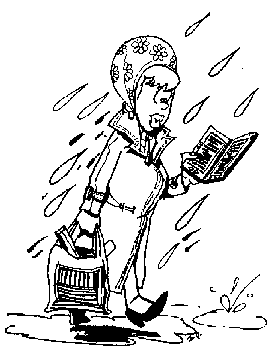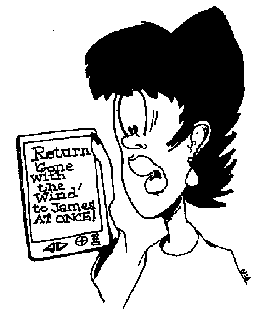
I have long been interested in the possibilities of electronic books (ebooks) and in 1995 wrote a short article, which is reprinted below, which was published in the "IEE Review". The machine I describe could be manufactured for a few hundred dollars today (February 2003) but nobody has yet done so. I would be interested to receive feedback and/or criticism of my ideas at james (a) jbryant.eu. One piece of feedback that I do get regularly suggests that I update the article - I do not wish to do this as I see it more as an historical exhibit rather than an up-to-date specification. I am also asked for links to ebooks that I approve. As I have not yet found one that meets my (demanding!) requirements I am not willing to do this either.
In its original form this article was written for an IEE Colloquium on Electronic Books in 1995. I was saddened to discover that the majority of the other speakers at the Colloquium regarded it as inevitable that the hardware platform of electronic books would be the ubiquitous personal computer (PC). I consider such a view unrealistic, and dangerous to the successful development of electronic books (which I shall refer to as "ebooks"). Although I am an electronic engineer and a computer user, this article is written more from the point of view of a book collector and reader with a collection of some 5,000 books than from that of a computer hardware designer. My speciality, after all, is precision analog integrated circuits, but I have been finding references to electronic books in science fiction for nearly forty years and building my own speculations upon them. The earliest references in the 1940's [1] and 1950's [2] treat ebooks (the term is not actually used) as bulky and unwieldy pieces of machinery which are kept somewhere that the reader has to visit in order to use the resource. By the 1960's [3] we meet the equivalent of a whole (law) library in a briefcase but the data are contained on "pinhead tapes" and the author does not discuss how these are handled or identified. Neither of these ideas is really satisfactory.
If ebooks are to replace paper ones they must be comparable in price and as convenient to use. They must be perceived by the bookbuying public as an improvement on the traditional paper book. This will not be best achieved by promoting entirely new features such as hypertext, valuable as they undoubtedly are, but by emphasising that electronic books can be made with nearly all the advantages of traditional paper books while overcoming many of their disadvantages. Such disadvantages include size, weight and environmental impact. (My 5,000 books occupy nearly 80 metres of shelf space and weigh about 1½ tons, which represents the woodpulp from at least one mediumsized tree.) Furthermore, despite improvements in paper and bookbinding technology over the last decade or two, many cheaper books are still being made of acid pulp paper with glued spines and may be expected to have a shelf life of no more than decades, which may fall to a few weeks if they are read repeatedly.

But it is important, most especially during their introduction, when they will inevitably be comparatively expensive, that the acceptance of electronic books is not delayed because their advantages are overweighed by disadvantages of size, weight, power supply and convenience of use. A standard computer of any size: desktop, notebook or palmtop, is not ideal for relaxed reading. If "The Electronic Book" is promoted as another function of the PC it may be accepted by professional users but will probably be seen as unacceptably inconvenient by many of the students and most of the recreational readers who represent a massively larger market and user base. Even among professional users a lawyer with whom I have recently discussed this point admits to taking Archbold [4] or Stone [5] to bed with her from time to time and would prefer something smaller.
What I would like is an object that I can carry anywhere and which allows me to read any book in my collection comfortably wherever I am, onehanded. This immediately places limits on size, weight and power requirements, and on the memory capacity of the "ebook":- if it is to be carried in a jacket pocket or a handbag it must be little larger than a standard sized paperback book (10.5x17.5x2.5 cm) and weigh no more than 500 gm. If it is to hold the 5,000 books in my collection it must have a storage capacity of at least two gigabytes.
This figure of 2 gigabytes assumes an average book to have 350 pages of 500 words per page and six letters per word or about one million letters per book. Without any compression this would suggest a book contains about a megabyte of data, but even quite simple compression schemes should be able to reduce this by 60%.
Using single bytes for the commonest 250 words in the language would achieve a much larger compression ratio, and if there were a statistical analysis of word use in each book (or even each chapter) and the commonest 250 words in the book (or chapter) were to be allocated a byte each it might be possible to achieve even more savings.
Half-tone or colour pictures and complex diagrams, of course, require considerably more memory, even with data compression, but most books are unillustrated, and many illustrated books contain relatively few pictures requiring much memory (many diagrams, for instance, are mostly text plus a few simple lines and curves).
Such a specification is not beyond today's technology, if a little expensive, and should be practicable at mass-market prices within a few years. It is therefore worth considering what other characteristics would be desirable in such an ebook.
It should be selfpowered and should run for at least ten hours on a single charge of its rechargeable batteries, and be able to be operated with line power during charging and with readily available primary (nonrechargeable) batteries should it run down where recharging is not possible. Any RAM in the ebook should be protected from memory loss in the event of loss of power. While it is desirable that an ebook should have its own illumination this will shorten battery life (or increase weight) so it should be designed to have the highest possible screen contrast so that it may easily be read by ambient light when this is available, and to be selfilluminated only when necessary. (When the ambient light level is high it might be used to charge the batteries by means of photocells, but this feature would add to the ebook's weight.)
The ebook should be waterproof, or at the very least splashproof.

I know only too well that as we get older our eyesight becomes less than perfect. An electronic book could compensate for this by offering a variety of fonts, and font sizes (in advanced ebooks fonts might be optimised for the imperfections in the eyesight of individual readers, and the option of entering spectacle prescriptions to achieve this could be available - this would not necessarily eliminate the need for spectacles but could minimise eyestrain). This implies, of course, that the number of "pages" in an ebook will vary according to the font settings, and indexes must correlate with position in the text rather than (variable) page numbers. Since we may change fonts or sizes as we read we will need electronic "bookmarks" to mark places to which we may wish to return (it is not possible to fold over the corner of an electronic page!)
The obvious way to move through the text is to have a button which "turns the page", but it may be more convenient to have a steady scroll whose speed is a function of the pressure on a knob or joystick. The choice should be available to the reader and since early habit is probably important in how an individual reads it may be a generation or two before it is clear which is a more practical way of reading. (Historically the paged book [codex] replaced the scrolled [rotulus] because it was more convenient, but this was more a matter of handling and placefinding than of actual ease of reading - which electronic format is easier to read is still undecided.) It should, of course, be possible to jump to another page (or another book), and possibly to view part of two or more texts simultaneously, by invoking other controls. Many readers will require the possibility of browsing among many books and many pages in a way analogous to browsing with traditional books. This will present designers of ebooks with challenges but it should not be impossible to do.
Turning pages requires two buttons (FORWARD and BACK) or a joysticklike control. Selection, browsing and other functions will require many more controls. The most obvious way to provide them is not to have innumerable buttons outside the screen area (which would reduce the display area of the ebook) but to make part of the screen a touch screen and convert part of it to a keyboard when more complex operations are required while using it for display purposes at other times. Such a keyboard would allow us to annotate the text as well, and remove annotations without trace when we have finished with them: some readers would regard this as essential, others, who regard writing on the pages of a paper book as desecration, might find it a valuable new feature of the ebook.
This touch screen allows the ebook to incorporate an (alarm) clock, a calculator, a notepad and a personal organiser (electronic diary). The additional cost of these functions is minimal and the value added considerable. Such an advanced ebook falls short of the functionality of a portable PC but may be adequate for many uses. Where full PC functionality is required an ebook might perform the display function while a small separate keyboard (with wire, or a radio or infrared data link) could contain the remainder of the electronics. This would eliminate the inconvenience of carrying two complete machines, and suggests that the value of ebooks could be enhanced by engineering them, at the outset, to be able to act as display devices for other equipment.
The technology exists to convert text into English speech (no doubt it is available in other languages too). Advanced ebooks should incorporate such technology, which is useful not only to the blind but to drivers and users of the Walkman©. DSP processing allows such speech to be faster than normal without loss of comprehensibility and without raising its pitch to Mickey Mouse frequencies. Within a decade or two at most the technology should also be available (in affordable, transportable form - it is available today in big mainframe computers) to translate text from one language to another in real time so that a suitably equipped ebook could provide translation as well as direct output.
So far I have considered only the technology, but if such electronic books are to be accepted it is necessary that there is material available in electronic form to read in them. This means that the majority of the traditional literary works of the last two millennia must quickly become available in ebook readable form. Publishers are, understandably, concerned that, if they publish books in electronic formats, piracy and loss of royalties will become unavoidable. It is with traditional books in electronic form that I am concerned in the remainder of this article.
If books are published on magnetic disks, optical CDROMs or similar media there is little to prevent users passing them around to be copied and recopied (besides, we do not want to have to carry our ebook plus a load of CDs, cartridges, cassettes, ROMs or whatever - this concern was roused long ago when I first read "Novice", the story referred to in footnote 3). It seems likely, therefore, that a successful ebook must contain a very large data store so that all the books we own may be contained within the ebook and not in disks and ROMs which might be copied. It will, in fact, be an "elibrary". When we buy a book in electronic form it will be written directly into the memory of our ebook. This may be done in a bookshop or over a telephone by means of a modem. If each ebook has a unique ID the modem transmission could be encoded so that only the destination ebook could make use of the information. The sale price of a reference work in such a format might include entitlement to free, or very cheap, updates as new editions are published. Of course a fullfeatured ebook should be able to distinguish between copyright and noncopyright material and permit unimpeded electronic output of the latter.
It is unlikely that remote downloading by modem will replace the bookshop. The design of a bookshop may change somewhat when the majority of books are published only in electronic form, but its basic functions, of displaying titles available (in many cases with an attractive "cover"), enabling prospective purchasers to browse and providing informed staff to discuss customers' needs, will remain unchanged and will provide ample justification for the survival of bookshops in something quite close to their present form.
Remote downloading would make it possible to receive newspapers and periodicals by telephone and read them from our ebook, thereby saving delivery costs and innumerable tons of newsprint (and trees). The replacement of paper newsprint by electronic communications is attractive not only on environmental grounds, but also because it would allow much wider availability of information - at present space constraints cause sub-editors to remove much material which minorities among their readers would value. Electronic newspapers could contain much more information and we could pursue only the issues which interest us. This would, of course, increase problems with Sturgeon's Law [6]. The topic of electronic newspapers merits not merely an article of its own but a whole book, or more.
But what of the pleasures of lending a favourite book to a friend? If we lend her our ebook hardware we have nothing to read while it is gone. If we can download the book to her ebook we have evaded the antipiracy protection. We might avoid both these problems by manufacturing ebooks so that they can pass material which is coded as copyright to another ebook only at the price of erasing the material from their own memories. We can thus truly lend a book, even in electronic form, and I can envisage transmitting it together with macros which cause reminders to appear on our friend's ebook at turnon urging her to return our book when she has read it! Books borrowed from libraries will automatically erase themselves after a preset period (which might be legally defined, and not very long).

Our ebook, being effectively an elibrary, will contain all the books that we own. If it is lost or stolen, or merely loses its memory, we will suffer a great loss. But, even with piracy protection, it might be possible to guard against this if we allow a backup data store which cannot be read directly but can be updated from our book, and from no other, and can update it and no other. If either is lost it can be restored by the manufacturer, who can, presumably, be trusted to preserve copyright.
There is also a logistic problem with the books we already own. A few may be beautifully bound or illustrated but in my case I should prefer most to be transferred to electronic form. Scanners are available which not only scan but interpret TIFF or similar image files as text. If we add a page turning mechanism to such a system we have a device which can transfer books to electronic form and I imagine such readers will become commonplace when ebooks are. If we treat such scanned in ebooks as copyright (i.e. they cannot be given away in electronic form) we have not morally affected the rights of the original copyright owner, although it might be necessary to change the law to permit such private transfers from one medium to another. It might be advisable to make such copiers very slow, so that widespread piracy is impracticable with them, and have high speed ones available (perhaps in libraries) which will make copies only on payment of a small royalty to the original publisher. The book scanner might also indelibly mark every page it scans with ultraviolet fluorescent ink and refuse to scan a book so marked so that one paper book could not be used to make multiple ebook copies.
More advanced legislation in an era of ebooks might address the issue of books which are out of print (present tax laws in some countries discourage publishers from maintaining stocks of slowselling books, and as a result many books for which there would be a small but steady continuing demand become unavailable far too early). With ebooks and electronic storage no book should ever again become unavailable once it has been published - if the original publisher is unwilling to retain it a potential reader should be entitled to download it from the British Museum, the Library of Congress or other Library of Record on payment of a minimal royalty.
This article is not exhaustive, but it contains the thoughts of a lifelong book collector excited by the possibility of getting rid of hundreds of feet of bookshelf containing, mostly, books printed on acid pulp paper which are slowly crumbling away, and replacing most of them with one or two small and convenient electronic devices which contain all the information in smaller, and more permanent, form. However, the essential feature of any practical electronic book is that I must be able to read it comfortably in bed.

Acknowledgements: I am most grateful for many critiques of my original paper, which have inspired a number of improvements to this version. Especial thanks are due to Barrie Gilbert, Jane Henderson, James and Thelma Martin, Paul Quarrie and Mike Rayner.
References:-
[1] "Space Cadet" Robert A. Heinlein, Putnam. 1948
[2] "Unwillingly to School" Pauline Ashwell, ASF (US Ed.) January 1958
[3] "Novice" James H. Schmitz, ASF (UK Ed.) October 1962
[4] "Criminal Pleading, Evidence & Practice (Archbold)", Sweet & Maxwell.
[5] "Stone's Justices Manual", Butterworth. This weighs 5.5 Kg!
[6] "Ninety percent of everything is crap" Theodore Sturgeon
This is a page on the James Bryant (G4CLF) Web-site.
You can email me with comments on this article at james (a) jbryant.eu.
Return to James Bryant's Home Page